

Hyaluronan. Hyaluronan (also called hyaluronic acid or hyaluronate or HA) is an anionic, nonsulfated glycosaminoglycan distributed widely throughout connective, epithelial, and neural tissues.

It is unique among glycosaminoglycans in that it is nonsulfated, forms in the plasma membrane instead of the Golgi, and can be very large, with its molecular weight often reaching the millions.[2] One of the chief components of the extracellular matrix, hyaluronan contributes significantly to cell proliferation and migration, and may also be involved in the progression of some malignant tumors.[3] Medical uses[edit] Hyaluronan has been used in attempts to treat osteoarthritis of the knee via injecting it into the joint. It has not been proven, however, to generate significant benefit and has potentially severe adverse effects.[8] Neuroflexyn - focus, memory and concentration formula - neuroflexyn.com. * These statements have not been evaluated by the FDA.

This product is not intended to diagnose, treat, cure or prevent any disease. If you are pregnant, nursing, or taking medication we suggest consulting with a physician before using any of our products. Copyright © 2015 GetNeuroflexyn. All Rights Reserved. | GetNeuroflexyn.com is a U.S. Based Company. Phosphatidylcholine. Phosphatidylcholines (PC) are a class of phospholipids that incorporate choline as a headgroup.
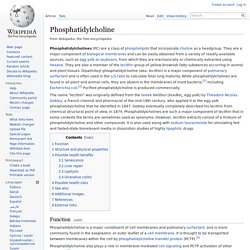
They are a major component of biological membranes and can be easily obtained from a variety of readily available sources, such as egg yolk or soybeans, from which they are mechanically or chemically extracted using hexane. They are also a member of the lecithin group of yellow-brownish fatty substances occurring in animal and plant tissues. Phospholipid. The left image shows a phospholipid, and the right image shows the chemical makeup.
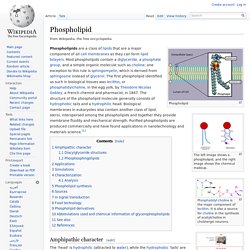
Phospholipids are a class of lipids that are a major component of all cell membranes as they can form lipid bilayers. Most phospholipids contain a diglyceride, a phosphate group, and a simple organic molecule such as choline; one exception to this rule is sphingomyelin, which is derived from sphingosine instead of glycerol. The first phospholipid identified as such in biological tissues was lecithin, or phosphatidylcholine, in the egg yolk, by Theodore Nicolas Gobley, a French chemist and pharmacist, in 1847.
The structure of the phospholipid molecule generally consists of hydrophobic tails and a hydrophilic head. Biological membranes in eukaryotes also contain another class of lipid, sterol, interspersed among the phospholipids and together they provide membrane fluidity and mechanical strength. Choline. Choline is a water-soluble essential nutrient.[1][2][3][4][5] It is usually grouped within the B-complex vitamins.
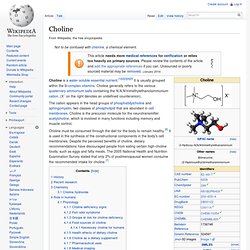
Choline generally refers to the various quaternary ammonium salts containing the N,N,N-trimethylethanolammonium cation. (X− on the right denotes an undefined counteranion). The cation appears in the head groups of phosphatidylcholine and sphingomyelin, two classes of phospholipid that are abundant in cell membranes. Choline is the precursor molecule for the neurotransmitter acetylcholine, which is involved in many functions including memory and muscle control. Choline must be consumed through the diet for the body to remain healthy.[6] It is used in the synthesis of the constructional components in the body's cell membranes. Sarcoidosis. Sarcoidosis, also called sarcoid, is a disease involving abnormal collections of inflammatory cells (granulomas) that can form as nodules in multiple organs.[1] The granulomas are most often located in the lungs or its associated lymph nodes, but any organ can be affected.[2] Sarcoidosis seems to be caused by an immune reaction to an infection or some other trigger (called an antigen) that continues even after the initial infection or other antigen is cleared from the body.[3] In most cases it clears up by itself without any medical intervention, but some cases go on to affect the person long-term or become life-threatening and require medical intervention, most often with medications.[2] 1 alpha, 25(OH)2 Vitamin D3 is the main cause for high blood calcium in sarcoidosis and is overproduced by sarcoid granulomata.
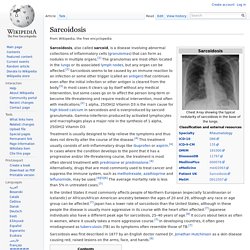
Gamma-interferon produced by activated lymphocytes and macrophages plays a major role in the synthesis of 1 alpha, 25(OH)2 Vitamin D3. Signs and symptoms[edit] Skin[edit] Infographic: What does the colour of your snot say about your health? Mucus alone isn't enough to diagnose disease, but it can give doctors useful insights into what's happening inside your body.
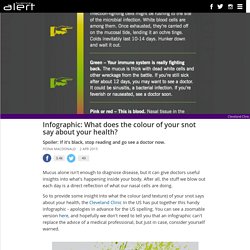
After all, the stuff we blow out each day is a direct reflection of what our nasal cells are doing. So to provide some insight into what the colour (and texture) of your snot says about your health, the Cleveland Clinic in the US has put together this handy infographic - apologies in advance for the US spelling. Kinesiology. A series of images that represent research (left) and practice (right) in the field of Academic Kinesiology Kinesiology is the scientific study of human or non-human body movement.
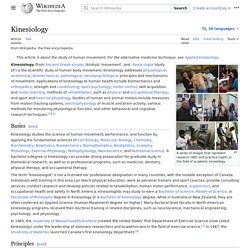
Kinesiology addresses physiological, biomechanical, and psychological dynamic principles and mechanisms of movement. Applications of kinesiology to human health (i.e., human kinesiology) include biomechanics and orthopedics; strength and conditioning; sport psychology; methods of rehabilitation, such as physical and occupational therapy; and sport and exercise. Applied kinesiology. Applied kinesiology (AK) is a technique in alternative medicine claimed to be able to diagnose illness or choose treatment by testing muscles for strength and weakness.[1] Applied kinesiologists are often chiropractors, but they may also be naturopathic physicians, physicians, nurses, physical therapists, or veterinarians.
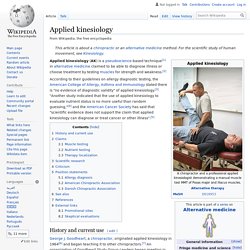
According to their guidelines on allergy diagnostic testing, the American College of Allergy, Asthma and Immunology stated there is “no evidence of diagnostic validity” of applied kinesiology,[2] and another study has shown that as an evaluative method, AK "is no more useful than random guessing",[3] and the American Cancer Society has said that "scientific evidence does not support the claim that applied kinesiology can diagnose or treat cancer or other illness".
Applied kinesiology, as described above, should not be confused with kinesiology, which is the scientific study of human movement. History and current use[edit] George J. Claims[edit] Scientific research[edit] Use your age as an excuse – I dare you. Ideomotor phenomenon. Ideomotor phenomenon is a psychological phenomenon wherein a subject makes motions unconsciously.
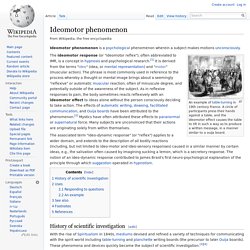
Purple carrots. Anthramycin. Chemical structure[edit] The chemical structure of anthramycin was first elucidated by Leimgruber using nuclear magnetic resonance and ultraviolet spectroscopy. Using another similarly structured fermentation product simply referred to as 'yellow pigment' as a basis of comparison, he was able to identify all major functional groups of the structure. The structure of the species was narrowed down to one of two possible candidates: one with a pyrrolobenzodiazepine nucleus, and another with a pyridoquinazoline skeleton. The first structure was confirmed through the use of mass spectrometry. Medical uses[edit] Anthramycin is an active anti-tumor agent and antibiotic. Side effects[edit] Hypernatremia - Endocrine and Metabolic Disorders - MSD Manual Professional Edition. FreeStyle Blood Glucose Meters. Ketones are a chemical produced by your body when, due to a lack of insulin, it is not able to use glucose as its source of energy, and instead start breaking down fat. ••••• What are ketones?
The body produces ketones by breaking down fat when blood glucose drops. Histidine. Histidine (symbol His or H)[2] is an α-amino acid that is used in the biosynthesis of proteins. It contains an α-amino group (which is in the protonated –NH3+ form under biological conditions), a carboxylic acid group (which is in the deprotonated –COO− form under biological conditions), and an imidazole side chain (which is partially protonated), classifying it as a positively charged amino acid at physiological pH. Initially thought essential only for infants, longer-term studies have shown it is essential for adults also.[3] It is encoded by the codons CAU and CAC.
Chemical properties[edit] The conjugate acid (protonated form) of the imidazole side chain in histidine has a pKa of approximately 6.0. This means that, at physiologically relevant pH values, relatively small shifts in pH will change its average charge. Aronia. Chokeberries are cultivated as ornamental plants and as food products. The sour berries can be eaten raw off the bush, but are more frequently processed.
They can be found in wine, jam, syrup, juice, soft spreads, tea, salsa, chili starters, extracts, beer, ice cream, gummies and tinctures.[8] The name "chokeberry" comes from the astringency of the fruits, which create a sensation making one's mouth pucker.[8] Identification and taxonomy[edit] Anthocyanin. Not to be confused with anthocyanidins, the sugar-free counterparts of anthocyanins. Anthocyanins give these pansies their dark purple pigmentation. Anthocyanins (also anthocyans; from Greek: ἀνθός (anthos) = flower + κυανός (kyanos) = blue) are water-soluble vacuolar pigments that may appear red, purple, or blue depending on the pH.
They belong to a parent class of molecules called flavonoids synthesized via the phenylpropanoid pathway; they are odorless and nearly flavorless, contributing to taste as a moderately astringent sensation. Insulin. Peptide hormone Insulin is a peptide hormone containing two chains cross-linked by disulfide bridges.
Insulin (,[5][6] from Latin insula, 'island') is a peptide hormone produced by beta cells of the pancreatic islets; it is considered to be the main anabolic hormone of the body.[7] It regulates the metabolism of carbohydrates, fats and protein by promoting the absorption of glucose from the blood into liver, fat and skeletal muscle cells.[8] In these tissues the absorbed glucose is converted into either glycogen via glycogenesis or fats (triglycerides) via lipogenesis, or, in the case of the liver, into both.[8] Glucose production and secretion by the liver is strongly inhibited by high concentrations of insulin in the blood.[9] Circulating insulin also affects the synthesis of proteins in a wide variety of tissues.
It is therefore an anabolic hormone, promoting the conversion of small molecules in the blood into large molecules inside the cells. What Is Type 1 Diabetes - JDRF Australia. Type 1 diabetes is a life-long autoimmune disease that usually occurs in childhood but can be diagnosed at any age. Type 1 diabetes. Type 1 diabetes is an auto-immune condition in which the immune system is activated to destroy the cells in the pancreas which produce insulin. We do not know what causes this auto-immune reaction. Type 1 diabetes is not linked to modifiable lifestyle factors. Hair Growth Miracle: “Accidental” Brazilian Discovery Leads to Longer, Thicker, Faster Hair Growth. By Eric Wright It sounds like something out of a movie. But a recent “accidental” discovery — with origins in the Brazilian rainforest - has led to some amazing results.
Truth Tobacco Industry Documents. Insulin. Losing just 1 gram of fat in the pancreas can reverse type 2 diabetes. Losing a single gram of fat could be enough to reverse the symptoms of type 2 diabetes – as long as that fat comes from the pancreas, researchers in the UK have shown. It's already known that weight loss can greatly help manage type 2 diabetes – a progressive condition where the body either stops being able to produce enough insulin, or becomes insensitive to it – but this is the first time that researchers have shown the exact type of weight loss that's needed to get the condition under control.